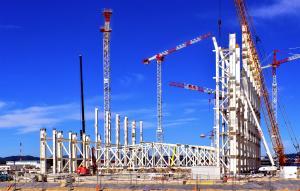Almost ready to lift
29 May 2015
-
R.A.
The 700-tonne roof will be 'pulled from above' by way of 22 hydraulic jacks connected through temporary cables to the top of the pillars.
For the past few years, most of the work in the Tokamak Complex area has been carried out below ground. From afar, not much was visible—ITER hadn't yet made a mark on its immediate environment.
But things are changing fast. The high cranes of the worksite and the white pillars of the Assembly Building have added new elements to the landscape of the Durance River Valley — one that motorists on the A51 thruway cannot miss.
The steel structure of the Assembly Building is only half complete but already spectacular: pillars made from four vertical segments rise close to 50 metres on the east side and half that height on the west; the roof support structure is being assembled on the floor below.
Less than three months from now, the metallic structure will have been built up to 60 metres on both sides of the basemat and the roof will be ready to be put into place.
Lifting this 700-tonne structure to such considerable height will be a long and delicate computer-monitored operation. "The roof will be 'pulled from above' by way of 22 hydraulic jacks connected through temporary cables to the top of the pillars," explains Miguel Curtido, from the European Domestic Agency which is in charge of construction works on the platform.
However rigid and sturdy the pillars—each individual segment measures 12 metres in length and weighs up to 23 tonnes—the structure is still flexible; wind and temperature can cause a 15-centimetre deflection at the top of the pillars.
"A structure design allowing flexibility during assembly is essential to maintaining the required tolerances," explains Miguel, "especially when we will install the overhead crane rails."
Following one month of preparation, roof lifting and assembly operations should take one full week and be completed in August. The rails for the double 750-tonne gantry cranes will be installed in October. At that point, workers will proceed with the installation of heating and ventilation systems (HVAC), electrical systems, etc.
By then, motorists on the A51 thruway and residents of the neighbouring villages will definitely have something to look at in awe.


